Japan Travelogue Hiraizumi
Yoshitsune is commemorated on a hill called Takadachi. Before you climb the steep slope—there are stone steps to make the climb easier—you may sense the anticipation: the top is said to offer a stupendous view of Hiraizumi and its surroundings.
Keep climbing, and suddenly the vista opens up. It is, in fact, stupendous, with the gentle contours of Mount Tabashine in the distance and the Kitakami River below. The immortal poet Matsuo Basho came here in 1689 and admired the same topographical features. While thinking about the rise and fall of the Oshu Fujiwara and the tragic end of Yoshitsune, he wrote this famous haiku:
Natsukusa ya / tsuwamono domo ga / yume no ato.
The thick summer grass / is all that remains now of / warlord ambitions.
After you climb down the hill, I would suggest a stop at Ochi-ya, an atelier and shop beside National Highway No. 4. Here the local Hidehira-nuri method is used to decorate lacquer ware. The shop has a wide variety of goods, from gorgeous Hidehira-wan bowls in tones of black, scarlet and gold, to reasonably priced sakazuki sake cups, chopsticks, and other objects that would make nice souvenirs.
Ekimae Basho-kan, a restaurant near the station, is a good place to enjoy the local cuisine served in bowls like these. Handmade buckwheat noodles (Hiraizumi wanko soba) arrive at your table in 24 bowls, each with enough for a mouthful. The set comes with a variety of seasonings to try one after the other.
After a good lunch, the next stop in our itinerary, about 10 minutes away on foot, is a fanciful garden at the site of the Motsu-ji Temple complex. Long ago, 40 buildings stood here, serving as a temple and monastery for more than 500 monks. It was a grand institution, more magnificent even than Chuson-ji Temple, and was completed under the second Fujiwara governor, Motohira, and the third, Hidehira. But flames consumed it several times, and today nothing remains but the formal garden. With its ornamental pond, Oizumi ga Ike, the garden recreates a scene of the Buddhist Pure Land, and people still find it soothing to the soul.
A number of ruins wait nearby to be explored, especially the sites of Kanjizaioin (once a temple with formal garden), and Muryokoin, which was built in the style of the Byodo-in Temple in Uji, near Kyoto. Another place of interest, 5.5 km from Motsu-ji, is an ancient Buddhist shrine called Takkoku no Iwaya Bishamon-do. It is a cave carved from the rocky cliff, and dates back to long before the days of the Fujiwara.
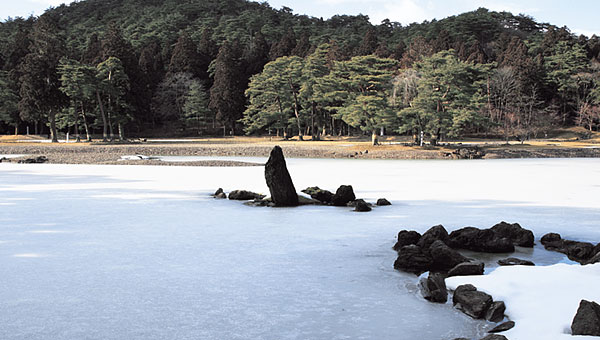
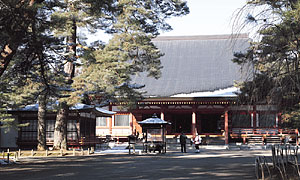
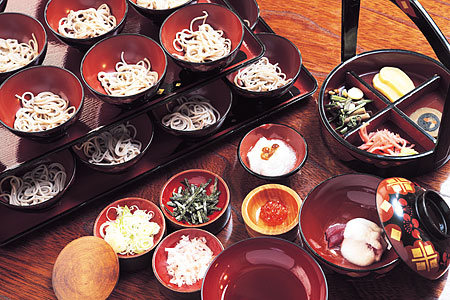
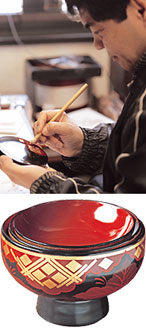
Above: Hiraizumi wanko buckwheat noodles served at Ekimae Basho-kan. The seasonings and condiments were chosen for the taste buds: tuna, yam, salmon roe, flakes of dried bonito fish, nori seaweed, green onion and more. Many customers at the restaurant ask for another helping.
Right top: An artisan attaching gold leaf to lacquer ware, in the Hidehira-nuri style.
Right: Lacquer bowls decorated in the Hidehira-nuri style, with a diamond motif of gold leaf offset with illustrations of flowering plants. Hiraizumi cultural traditions at their best.
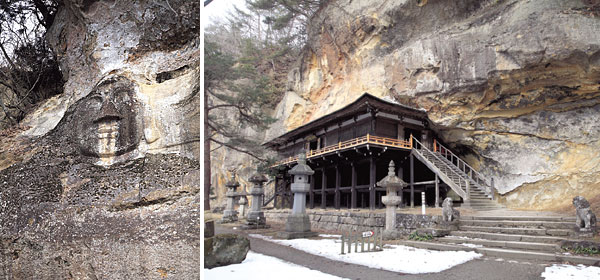
After the military leader Sakanoue no Tamuramaro subdued this area in 801, he gave thanks to the Buddha’s intervention by having the Takkoku no Iwaya Bishamon-do Hall constructed here. It is said to have been modeled on Kiyomizu-dera Temple in Kyoto. (Above right)
A magai butsu Buddhist image (above left) was carved on the rock face beside the hall.